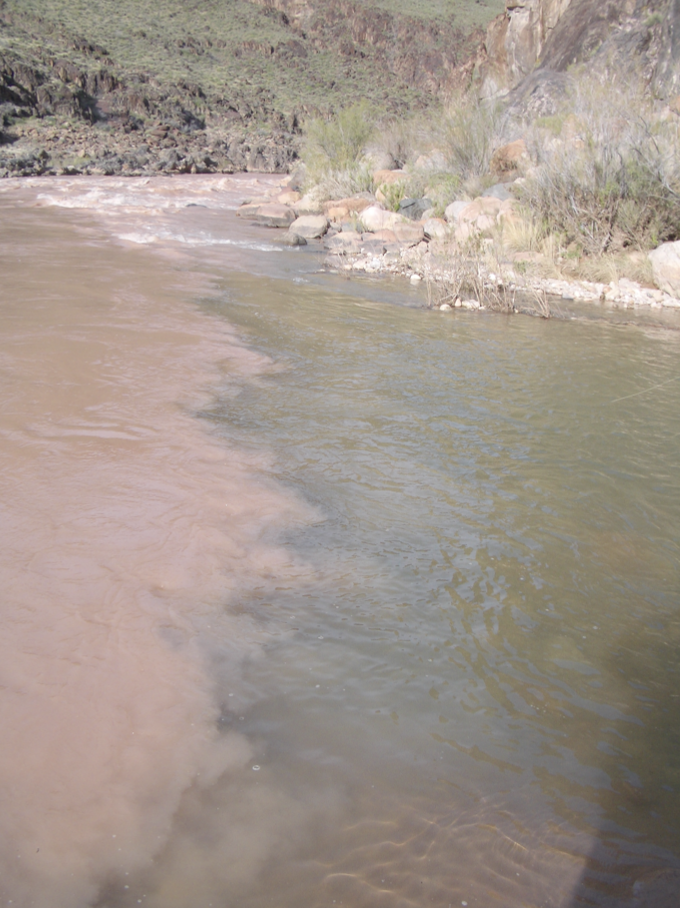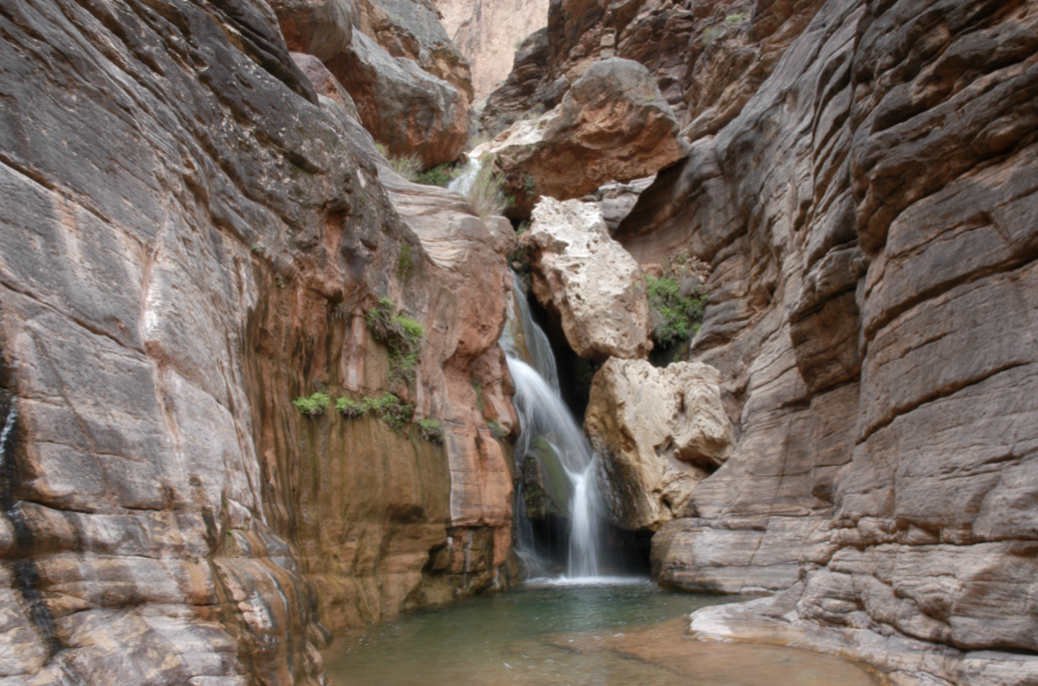Due to warmer temperatures, clear waters and a productive invertebrate community, Shinumo Creek is among the tributaries that historically provided good foraging and rearing habitat for the Colorado Rivers native fishes. Both Shinumo Creek and Elves Chasm are among the clear water tributaries that Henery (2005) hypothesized could be colonized by trout or other invasive species displaced downstream by the November 2004 flood or by the high ramping rates of the trout and tamarisk “perturbation” flows. Hook-and-line sampling and snorkeling observation at both Shinumo Creek and Elves Chasm suggested that there were very few fish present at either location. We hypothesize that the absence of fish at the time of observation can be attributed to unusually high flows in Shinumo Creek and recent high flows or fishermen in Elves Chasm.

Figure 1 – Shinumo Creek looking toward the Colorado River. (Photo C. Hammersmark)

Figure 2 - Blending water at the Shinumo Creek Colorado River confluence. During our observation rising river levels caused creek water to pool up at the mouth of Shinumo, expanding fish habitat. (Photo C. Hammersmark)
Upon our arrival at Shinumo Creek, flow in the mainstem was rising but still low enough to expose two large bars at the Shinumo Creek Colorado River confluence. The creek appeared to be good fish habitat with a visible riffle pool sequence upsteam and a large pool at the confluence. The confluence pool appeared to be formed in part by the high flows in the Creek backing up as they resisted mixing with the colder more turbid waters in the rising mainstem. The clear water to turbid water transition marked the downstream limit of our sampling area. A waterfall just a short ways upstream provided a natural barrier for fish passage and defined the upper end of our sampling area.
Hook-and-line sampling was conducted the length of lower Shinumo, excluding the waterfall pool, but yielded no results. However, a fish of unknown species was sighted surfacing at the mouth of the confluence once the water in the mainstem had come up high enough to inundate the larger of the two bars.
Snorkeling observation was performed in all sections from the waterfall pool to the mouth pool. Two small fish (<3 inches) of unknown species were observed at the entrance to the mouth pool. Fish did not appear to be present in any other portion of the Creek.

Figure 3 – Waterfall and upper Elves Chasm pool. Though no fish were present, invertebrate biomass and diversity were high throughout elves chasm (Photo R. Henery)
Flow in Elves Chasm (Royal Arches Creek) was also medium to high at the time of our visit, but unlike Shinumo Creek, was not strong enough at the time of observation to create scour or wash trout from the waterfall fed lower pools. Given this, it seems unlikely that the lack of fish in Elves Chasm was solely the result of high flows. Our invertebrate sampling reinforced this idea. Sampling at Elves chasm revealed high invertebrate diversity and biomass. At Shinumo, however, invertebrate biomass was low, though taxanomic diversity was high, suggesting that the high flows had decreased the number of invertebrates present.
We hypothesize that the absence of fish and low abundance of invertebrates in Shinumo Creek was the result of unusually high flows. The solid rock walls of Shinumo creek drop directly into the channel with little or no undercutting and few spots for fish to take refuge from strong current. At the time of observation, flow in Shinumo was sufficiently strong to scour gravel and initiate bedload transport of small gravel and fines (Henery and Booth 2005, this volume) suggesting that clinging benthic invertebrates and fish may have been displaced as well.
The absence of fish in Elves Chasm may also have been the result of high flows. Our river guides reported having seen trout in the lower Elves Chasm pool the previous summer, and the clear lentic waters of the lower Elves Chasm pool looked to be ideal fish habitat. However, the high invertebrate biomass at Elves was not necessarily consistent with the high flow hypothesis. Though invertebrates often recolonize areas faster than fish after a major disturbance, it seemed odd that fish had not yet recolonized the lower pool at Elves Chasm given turbid mainstem conditions. Given this, and the high traffic nature of the location, we hypothesized that trout had been removed or scared from the lower Elves Chasm pool by fishermen or hikers and that there had not been sufficiently high flows since the time of their removal to displace trout from further upstream and facilitate recolonization.
With little fish presence, native or invasive, sampling at Shinumo Creek and Elves Chasm did not support the hypothesis that the November 2004 flood would increase tributary invasion by non-native mainstem residents such as rainbow trout. However, given the high flows at the time of sampling, historic accounts of trout presence from river guides, and in the case of Elves Chasm, the popularity of the location, it is easy to imagine that any impacts of the November 2004 flood on invasive fish populations in these tributaries had been masked by the time of our visit. Regardless, we were puzzled by the lack of fish in Elves Chasm as it clearly provides superior habitat to the mainstem Colorado River.
REFERENCES
Henery, R.H. 2005. “Clear-water tributaries of the Colorado River in the Grand Canyon, Arizona: stream ecology and the potential impacts of managed flow.” In. J. Mount, P. Moyle and C. Hammersmark (eds.). Ecogeomorphology of the Grand Canyon and its Tributary Streams. Davis, CA. http://watershed.ucdavis.edu/grand_canyon/history.html.
Henery, R.H. and Booth, E.G. 2005. “Bedload Transport at Shinumo Creek.” In. J. Mount, P. Moyle and C. Hammersmark (eds.). Ecogeomorphology of the Grand Canyon and its Tributary Streams. Davis, CA. http://watershed.ucdavis.edu/grand_canyon/history.html.
